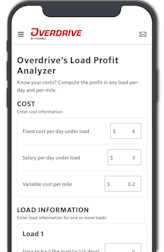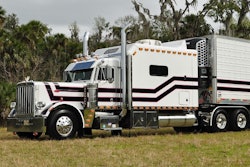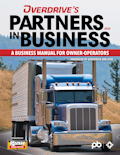It's likely you're well aware of the post-election news: Former President Donald Trump has garnered electoral college votes sufficient to send him back to the White House. In the run-up to the election, we ran this story examining the trucking-related record from his first term in office -- 2017-2021 -- slightly updated November 6, 2024, to reflect election results. Keep tuned for further post-election coverage and analysis in the coming weeks.
Original story follows.
In various ways, it’s no surprise that much of the trucking industry’s political support has been firmly behind the Republican presidential candidate, former President Donald Trump. As reported, a majority of trucking interests has tilted giving heavily toward each election's Republican Party candidate in every presidential election at least as far back as 1992, according to data compiled by OpenSecrets.
Looking at the Trump administration’s four years in office, two memos issued at the very beginning of his term had possibly the biggest impact on trucking regulations. One was a regulatory freeze that barred federal agencies from enacting new regulations for a time. The other was a two-for-one order, requiring federal agencies to remove two regulations for each new regulation proposed.

Halting regulations-in-process
While a regulatory freeze is fairly typical for any incoming administration, Trump’s benefited those in trucking who saw potential negative outcomes for some regulatory efforts then in the works. Namely, the speed limiter mandate attempt at the time, which was officially shelved in June 2017, a sleep apnea screening rulemaking fully withdrawn the same month, and a safety rating revamp that would have tied Safety Fitness Determinations for carriers directly to roadside inspection data, also withdrawn. Efforts to revamp federal carrier safety rating re-emerged under Trump's successor, President Biden, with a measured approach to engage stakeholders in and around trucking on just how to do that.
Efforts toward a speed limiter mandate for trucks were renewed in 2021 after the Biden administration took office.
[Related: Speed limiters at 68 mph still speculation, but drivers hate it anyway]
Independent contractor classification
Trump’s administration also changed how independent contractors were classified by the Department of Labor. First, in 2017, Trump's DOL rescinded a 2015 memo that changed the interpretation of federal wage and hour laws regarding owner-operators’ employment status. The July 2015 memo issued by David Weil, head of the Labor Department’s wage and hour division under President Obama, in effect instructed businesses and state agencies to view leased owner-operators as employees, as it effectively said anyone economically dependent on one entity and who were tied exclusive to that entity were employees.
That ran in direct contradiction of the carve-out for leased owner-operators in the federal Truth in Leasing regulations that enshrined in federal law a requirement for owner-operator exclusivity for leased-on validity.
Then, at the very end of Trump's term in January 2021, the Labor Department published a final rule clarifying the definition of independent contractor as it relates to the Fair Labor Standards Act. Following challenges by the Biden administration, the rule eventually took effect in March 2022. It was later rescinded and replaced by the Biden DOL.
Hours of service changes
The Federal Motor Carrier Safety Administration under Trump followed up on the electronic logging device mandate, implemented under Trump in 2017 yet mandated by Congress and finalized under the Obama administration, with hours of service changes that offered a modicum of flexibility -- in the form of more split-sleeper berth options and adjustment to short-haul rules and the required 30-minute break.
The 2020 HOS changes allowed truck drivers to split the 10-hour off-duty period into windows of up to seven hours and three hours, an increase over the prior eight-hour, two-hour option. Crucially, the shorter of the two periods in a split could now be excluded from the 14-hour duty window, allowing drivers to "stop the clock" with at least two hours of rest.
[Related: Rolling the 14: How to pull off the split-sleeper in the hours of service regs]
Changes were also made to how drivers were required to take their 30-minute break. The 2020 rule allowed drivers to use the break in an on-duty, not-driving status and required it within their first eight hours of drive time, rather than their first eight hours on-duty.
According to Overdrive polling in 2022, 65% of owner-operators reported some productivity improvement as a result of the 2020 HOS changes.
Broker transparency
The debate over broker transparency long predates the Trump administration, yet in the midst of the dramatic fall-off in freight around the COVID lockdowns during Trump's final year in office, it gained new energy as truckers protested for weeks outside the White House. Some among truckers in attendance were invited to attend a meeting with President Trump’s Chief of Staff, Mark Meadows, and Jim Mullen, FMCSA's acting administrator at the time.
The Owner-Operator Independent Drivers Association in May 2020 wrote to Congress asking that a provision be included in legislation to require brokers to immediately provide an electronic copy of each transaction record, including what the shipper paid, after a load is hauled, and prohibit brokers from including provisions in their contracts that require a carrier to waive their rights to access the transaction records. OOIDA then filed a petition for rulemaking with FMCSA to require it.
With other orgs also weighing the issue and with records disclosure stipulations already in fact in regulation, FMCSA held a listening session late in Trump's term in October 2020 to hear from truckers, brokers and other stakeholders. FMCSA accepted public comments on petitions to amend the transparency regulations in late 2020.
Action on the matter has been slow since, with FMCSA promising a rulemaking that remains on regulatory calendars for this month.
[Related: Broker margins, rates data, transparency: What owner-operators really think]
Tax reform
In late December 2017, Trump signed the Tax Cuts and Jobs Act reform law, which at the time cut owner-operators' tax liabilities. The legislation also removed the tax penalties for not having health insurance for individuals, which had been required under the Affordable Care Act. The law also doubled the standard tax deduction for all filers, yet employee truck drivers lost the ability to use the per diem deduction, in some cases adversely affecting tax liabilities.
The law created so-called bonus depreciation on purchases of used trucks and trailers. Prior tax law allowed bonus depreciation only for purchases of new equipment.
What to expect with another Trump administration
The slowdown of new regulations that was a theme during the first Trump administration is likely again be the case with a second, according to Don Hicks, supply chain expert and CEO of global supply chain optimization firm Optilogic, speaking in a recent episode of Overdrive sister publication CCJ's 10-44 webisode series. Hicks noted he believes a second Trump administration would slow down the current push toward electric vehicles. "There will certainly not be a focus on increasing regulation and driving towards the electric vehicle and the sort of carbon emissions direction," he said.
[Related: EPA 2027 diesel emissions regs: Class 8 truck price hikes in the offing]
In an Aug. 15 speech in Bedminster, New Jersey, Trump talked rather extensively about trucks, particularly electric trucks. “We want to end the Biden-Harris electrical vehicle mandate,” he said. “We have to get rid of the electric vehicle mandate.” That's likely a reference to the Environmental Protection Agency's emissions standards enacted earlier this year for light- and medium-duty vehicles beginning with the 2027 model year. Similar to EPA's Phase 3 Greenhouse Gas regulations for heavy-duty trucks, the standards are officially technology-neutral, yet stringent enough to ensure EVs are a bigger part of automakers' production mix, likewise truck makers'.
Specifically speaking about trucks in the speech, Trump alluded to the range challenges that electric trucks currently on the market present compared to their diesel counterparts, likewise the weight challenges. Trump concluded the EV portion of his speech with a vow to “repeal all that."
[Related: Kamala Harris' trucking record: 'Dirty diesel' regs and how you might be taxed]











